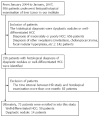Differentiation between dysplastic nodule and early-stage hepatocellular carcinoma: the utility of conventional MR imaging
- PMID: 24259975
- PMCID: PMC3831226
- DOI: 10.3748/wjg.v19.i42.7433
Differentiation between dysplastic nodule and early-stage hepatocellular carcinoma: the utility of conventional MR imaging
Abstract
Aim: To elucidate the variety of ways early-stage hepatocellular carcinoma (HCC) can appear on magnetic resonance (MR) imaging by analyzing T1-weighted, T2-weighted, and gadolinium-enhanced dynamic studies.
Methods: Seventy-three patients with well-differentiated HCC (wHCC) or dysplastic nodules were retrospectively identified from medical records, and new histological sections were prepared and reviewed. The tumor nodules were categorized into three groups: dysplastic nodule (DN), wHCC compatible with Edmondson-Steiner grade I HCC (w1-HCC), and wHCC compatible with Edmondson-Steiner grade II HCC (w2-HCC). The signal intensity on pre-contrast MR imaging and the enhancing pattern for each tumor were recorded and compared between the three tumor groups.
Results: Among the 73 patients, 14 were diagnosed as having DN, 40 were diagnosed as having w1-HCC, and 19 were diagnosed as having w2-HCC. Hyperintensity measurements on T2-weighted axial images (T2WI) were statistically significant between DNs and wHCC (P = 0.006) and between DN and w1-HCC (P = 0.02). The other imaging features revealed no significant differences between DN and wHCC or between DN and w1-HCC. Hyperintensity on both T1W out-phase imaging (P = 0.007) and arterial enhancement on dynamic study (P = 0.005) showed statistically significant differences between w1-HCC and w2-HCC. The other imaging features revealed no significant differences between w1-HCC and w2-HCC.
Conclusion: In the follow-up for a cirrhotic nodule, increased signal intensity on T2WI may be a sign of malignant transformation. Furthermore, a noted loss of hyperintensity on T1WI and the detection of arterial enhancement might indicate further progression of the histological grade.
Keywords: Dysplastic nodule; Hepatocellular carcinoma; Histological grading; Magnetic resonance imaging; Well-differentiated hepatocellular carcinoma.
Figures
Similar articles
-
MR characterisation of dysplastic nodules and hepatocarcinoma in the cirrhotic liver with hepatospecific superparamagnetic contrast agents: pathological correlation in explanted livers.Radiol Med. 2009 Dec;114(8):1267-82. doi: 10.1007/s11547-009-0464-9. Epub 2009 Nov 9. Radiol Med. 2009. PMID: 19902328
-
Characterization of hyperintense nodules on T1-weighted liver magnetic resonance imaging: comparison of Ferucarbotran-enhanced MRI with accumulation-phase FS-T1WI and gadolinium-enhanced MRI.J Chin Med Assoc. 2011 Feb;74(2):62-8. doi: 10.1016/j.jcma.2011.01.013. Epub 2011 Feb 12. J Chin Med Assoc. 2011. PMID: 21354082
-
MR features of regenerative nodules and dysplastic nodules in the cirrhotic liver.J Huazhong Univ Sci Technolog Med Sci. 2005;25(5):601-3. doi: 10.1007/BF02896030. J Huazhong Univ Sci Technolog Med Sci. 2005. PMID: 16463687
-
Magnetic resonance imaging of hepatocellular carcinoma.Gastroenterology. 2004 Nov;127(5 Suppl 1):S144-52. doi: 10.1053/j.gastro.2004.09.028. Gastroenterology. 2004. PMID: 15508078 Review.
-
Hepatocellular nodules in liver cirrhosis: contrast-enhanced MR.Abdom Imaging. 2011 Jun;36(3):290-9. doi: 10.1007/s00261-011-9687-z. Abdom Imaging. 2011. PMID: 21267561 Review.
Cited by
-
The relative net health benefit of liver resection, ablation, and transplantation for early hepatocellular carcinoma.World J Surg. 2015 Jun;39(6):1474-84. doi: 10.1007/s00268-015-2987-7. World J Surg. 2015. PMID: 25665675
-
Overall diagnostic accuracy of different MR imaging sequences for detection of dysplastic nodules: a systematic review and meta-analysis.Eur Radiol. 2022 Feb;32(2):1285-1296. doi: 10.1007/s00330-021-08022-5. Epub 2021 Aug 6. Eur Radiol. 2022. PMID: 34357448
-
Detection of Endogenous Iron Reduction during Hepatocarcinogenesis at Susceptibility-Weighted MR Imaging: Value for Characterization of Hepatocellular Carcinoma and Dysplastic Nodule in Cirrhotic Liver.PLoS One. 2015 Nov 25;10(11):e0142882. doi: 10.1371/journal.pone.0142882. eCollection 2015. PLoS One. 2015. PMID: 26605946 Free PMC article.
-
Gd-EOB-DTPA-enhanced magnetic resonance imaging combined with T1 mapping predicts the degree of differentiation in hepatocellular carcinoma.BMC Cancer. 2016 Aug 12;16:625. doi: 10.1186/s12885-016-2607-4. BMC Cancer. 2016. PMID: 27520833 Free PMC article.
-
Multi-phase contrast-enhanced magnetic resonance image-based radiomics-combined machine learning reveals microscopic ultra-early hepatocellular carcinoma lesions.Eur J Nucl Med Mol Imaging. 2022 Jul;49(8):2917-2928. doi: 10.1007/s00259-022-05742-8. Epub 2022 Mar 1. Eur J Nucl Med Mol Imaging. 2022. PMID: 35230493 Free PMC article.
References
-
- Parkin DM, Bray F, Ferlay J, Pisani P. Global cancer statistics, 2002. CA Cancer J Clin. 2005;55:74–108. - PubMed
-
- Donato F, Tagger A, Chiesa R, Ribero ML, Tomasoni V, Fasola M, Gelatti U, Portera G, Boffetta P, Nardi G. Hepatitis B and C virus infection, alcohol drinking, and hepatocellular carcinoma: a case-control study in Italy. Brescia HCC Study. Hepatology. 1997;26:579–584. - PubMed
-
- Kudo M. Multistep human hepatocarcinogenesis: correlation of imaging with pathology. J Gastroenterol. 2009;44 Suppl 19:112–118. - PubMed
-
- Szklaruk J, Silverman PM, Charnsangavej C. Imaging in the diagnosis, staging, treatment, and surveillance of hepatocellular carcinoma. AJR Am J Roentgenol. 2003;180:441–454. - PubMed
Publication types
MeSH terms
Substances
LinkOut - more resources
Full Text Sources
Other Literature Sources
Medical


